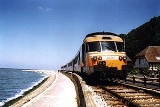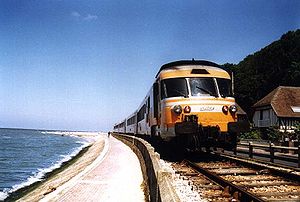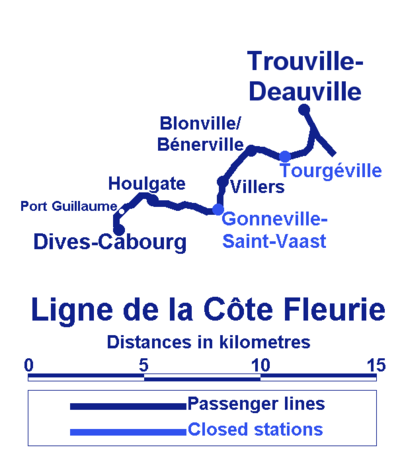
Ligne de la Côte Fleurie
Encyclopedia

Côte Fleurie
Côte Fleurie is part of the Lower Normandy coast on the English Channel in the North of the Pays d'Auge, it constitutes the Eastern coast of the department Calvados....
, Calvados
Calvados
The French department of Calvados is part of the region of Basse-Normandie in Normandy. It takes its name from a cluster of rocks off the English Channel coast...
, France
France
The French Republic , The French Republic , The French Republic , (commonly known as France , is a unitary semi-presidential republic in Western Europe with several overseas territories and islands located on other continents and in the Indian, Pacific, and Atlantic oceans. Metropolitan France...
.
The railway line, which is approximately 20 km (12 mi) long, was built in sections between 1882 and 1884. The unelectrified line runs between Deauville
Deauville
Deauville is a commune in the Calvados département in the Basse-Normandie region in northwestern France.With its racecourse, harbour, international film festival, marinas, conference centre, villas, Grand Casino and sumptuous hotels, Deauville is regarded as the "queen of the Norman beaches" and...
and Dives-sur-Mer
Dives-sur-Mer
-Transport:Dives-sur-Mer is on the line from Deauville to Dives-sur-Mer. The station is open, train services operate year round at weekends as well as on week days during the summer season. Dives is also on line #20 of the Calvados bus company Bus Verts du Calvados....
along the English Channel
English Channel
The English Channel , often referred to simply as the Channel, is an arm of the Atlantic Ocean that separates southern England from northern France, and joins the North Sea to the Atlantic. It is about long and varies in width from at its widest to in the Strait of Dover...
through countryside and is operated by Diesel multiple units.
History
The line was built in three sections between 1882 and 1884. The first section was built between Dives-sur-Mer and HoulgateHoulgate
Houlgate is a small tourist resort in northwestern France along the English Channel with a beach and a casino. It is a commune in the Drochon Valley, in the Calvados department in the Basse-Normandie region.-Pre-19th century:...
in 1882 as an extension of a railway line from Mézidon-Canon
Mézidon-Canon
-References:*...
on the main railway line between Paris
Paris
Paris is the capital and largest city in France, situated on the river Seine, in northern France, at the heart of the Île-de-France region...
and Caen
Caen
Caen is a commune in northwestern France. It is the prefecture of the Calvados department and the capital of the Basse-Normandie region. It is located inland from the English Channel....
. A second portion of the railway line was built from Deauville to Villers-sur-Mer
Villers-sur-Mer
-Places of interest:Villers-sur-Mer is known for the large topiary dinosaurs facing the sea from the garden of the office of tourism. In certain years, a baby dinosaur is added to the garden....
later in 1882, as a spur of the main line originating from Lisieux
Lisieux
Lisieux is a commune in the Calvados department in the Basse-Normandie region in northwestern France.Lisieux is the capital of the Pays d'Auge area, which is characterised by valleys and hedged farmland...
on the railway line between Paris and Caen. The last section between Houlgate, then called Beuzeval, and Villers-sur-Mer opened in 1884.
Traditional service was steam trains from Paris
Gare Saint-Lazare
Paris Saint-Lazare is one of the six large terminus train stations of Paris. It is the second busiest in Paris, behind the Gare du Nord, handling 274,000 passengers each day.-History:...
and to Caen
Gare de Caen
Caen, Gare de l'Ouest or Gare Calvados, is the main and now only station serving the city of Caen. The station stands on the main line from Paris to Cherbourg and although it mainly is an intercity station many regional trains use the station. Typical services link Caen to Lisieux, Evreux, Paris,...
. Rail services were operated by steam locomotives until 1975, when hauling of trains was entrusted to the turbotrain
SNCF Class T 2000
SNCF Class T 2000 trainsets, also known under their French acronym RTG , were the second generation of turbine-powered trains in France and saw commercial service from 1972 to 2004....
. This lasted until 1996 when the line lost its main line status, Grandes Lignes, and became a regional railway line, TER. Trains were then hauled by X 4500
SNCF Class X 4500
The SNCF Class X 4500 diesel multiple units were built by ANF between 1963-1970. The X4500 class are one of four classes of similar design known as "Caravelles" as when built the engine sound reminded railwaymen of the contemporary French SE210 'Caravelle' jet airliner. X4500 are identical to the...
and no direct trains to Paris ran.
Operation today
From 2003, rail services have been operated by X 73500SNCF Class X 73500
The X73500 is a Diesel Multiple Unit train type operated by the SNCF in France. They were built from 1999 to 2004 by Alsthom DDF.-General Information:...
DMUs.
The track is being replaced and wooden sleepers replaced by concrete sleepers to permit trains to run at speeds of 100 km/h (62.1 mph) instead of the 40 kilometre per hour currently in force.
There are no junctions along the line and no luminous signalling. The only forms of signalling are speed signs, level crossing number boards and distance markers (in hectometres and kilometres). The only point work is situated at Trouville-Deauville
Gare de Trouville-Deauville
Trouville-Deauville is the station for the towns of Deauville and Trouville-sur-Mer. The station is built in neo-normand architecture and is a terminus for two railway lines, the main line from Paris by Lisieux and the Côte Fleurie branchline to Dives-Cabourg.The line from Paris and Lisieux opened...
station and enables joint operation with the line to Paris and in the yard preceding Dives-sur-Mer
Gare de Dives-Cabourg
Dives-Cabourg is the railway station for the towns of Dives-sur-Mer and Cabourg. The station is built in Ouest architecture and is a terminus for the Côte Fleurie branchline to Trouville-Deauville....
which has been mothballed.
On Sunday 28 February 2010 a tree fell on the line between railway crossings PN87 and PN88 near the Golf de Houlgate. Traffic was interrupted whilst the tree was removed from under the train
SNCF Class X 73500
The X73500 is a Diesel Multiple Unit train type operated by the SNCF in France. They were built from 1999 to 2004 by Alsthom DDF.-General Information:...
's front bogie
Bogie
A bogie is a wheeled wagon or trolley. In mechanics terms, a bogie is a chassis or framework carrying wheels, attached to a vehicle. It can be fixed in place, as on a cargo truck, mounted on a swivel, as on a railway carriage/car or locomotive, or sprung as in the suspension of a caterpillar...
.
Route
The line begins at Trouville-DeauvilleGare de Trouville-Deauville
Trouville-Deauville is the station for the towns of Deauville and Trouville-sur-Mer. The station is built in neo-normand architecture and is a terminus for two railway lines, the main line from Paris by Lisieux and the Côte Fleurie branchline to Dives-Cabourg.The line from Paris and Lisieux opened...
and ends at Dives-sur-Mer
Gare de Dives-Cabourg
Dives-Cabourg is the railway station for the towns of Dives-sur-Mer and Cabourg. The station is built in Ouest architecture and is a terminus for the Côte Fleurie branchline to Trouville-Deauville....
. Six stations are served as well as a halt. Leaving Deauville southeasterly, the line follows the track of the line to Lisieux
Gare Principale Lisieux
is the main station for the town of Lisieux and was built by CF de l'Ouest in 1855. The station is built in a Y shape and is situated on the Mantes-la-Jolie–Cherbourg railway main line from Paris to Caen and Cherbourg. The station is also served by trains to Trouville-Deauville...
. In the commune of Saint-Arnoult
Saint-Arnoult
Saint-Arnoult is the name or part of the name of several communes in France:*Saint-Arnoult, Calvados, in the Calvados département*Saint-Arnoult, Loir-et-Cher, in the Loir-et-Cher département*Saint-Arnoult, Oise, in the Oise département...
the line leaves the main line to take a curved westerly course towards Tourgéville on a steady grade up to PN 107
Level crossing
A level crossing occurs where a railway line is intersected by a road or path onone level, without recourse to a bridge or tunnel. It is a type of at-grade intersection. The term also applies when a light rail line with separate right-of-way or reserved track crosses a road in the same fashion...
. The line then travels towards Blonville-sur-Mer and Villers-sur-Mer
Gare de Villers-sur-Mer
Villers-sur-Mer is the station for the town of Villers-sur-Mer. The station is built in Ouest architecture and is on the Côte Fleurie branchline from Trouville-Deauville and to Dives-Cabourg....
a few metres above sea level. From Villers-sur-Mer
Villers-sur-Mer
-Places of interest:Villers-sur-Mer is known for the large topiary dinosaurs facing the sea from the garden of the office of tourism. In certain years, a baby dinosaur is added to the garden....
the line rises to an altitude of 130 m (426.5 ft) to reach the closed station of Gonneville-Saint-Vaast. The line then observes a downward grade in the Drochon valley towards Houlgate
Gare de Houlgate
Houlgate is the train station for the town of Houlgate, Calvados department, northwestern France. The station is built in Ouest architecture and is on the Côte Fleurie branchline from Trouville-Deauville and to Dives-Cabourg....
. After Houlgate
Houlgate
Houlgate is a small tourist resort in northwestern France along the English Channel with a beach and a casino. It is a commune in the Drochon Valley, in the Calvados department in the Basse-Normandie region.-Pre-19th century:...
the line proceeds onto a 500 m (1,640.4 ft) long steel and brick viaduct across several streets as well as the Drochon. At the end of the viaduct, the line proceeds to PN 83
Level crossing
A level crossing occurs where a railway line is intersected by a road or path onone level, without recourse to a bridge or tunnel. It is a type of at-grade intersection. The term also applies when a light rail line with separate right-of-way or reserved track crosses a road in the same fashion...
and crosses Rue des Bains next to the River Dives
Dives River
The Dives is a 105 km long river in the Pays d'Auge, Normandie, France. It flows into the English Channel in Cabourg.The source of the Dives is near Exmes, in the Orne department...
. The line then proceeds towards Dives-sur-Mer
Gare de Dives-Cabourg
Dives-Cabourg is the railway station for the towns of Dives-sur-Mer and Cabourg. The station is built in Ouest architecture and is a terminus for the Côte Fleurie branchline to Trouville-Deauville....
along the Dives and Rue des Bains on a portion of railway line famous for its beauty. The line is then situated between the Mont de Caumont hill and the RD513 road. After passing Port of Dives-sur-Mer
Port of Dives-sur-Mer
The Port of Dives-sur-Mer, Port de Dives-sur-Mer, is the harbour of the Norman town of Dives-sur-Mer, France. It is from this harbour that William the Conqueror left for England to claim the throne.-History:...
, the line reaches Dives-sur-Mer
Gare de Dives-Cabourg
Dives-Cabourg is the railway station for the towns of Dives-sur-Mer and Cabourg. The station is built in Ouest architecture and is a terminus for the Côte Fleurie branchline to Trouville-Deauville....
after passing the only yard of the line, now closed.

Mézidon-Canon
-References:*...
and Caen
Gare de Caen
Caen, Gare de l'Ouest or Gare Calvados, is the main and now only station serving the city of Caen. The station stands on the main line from Paris to Cherbourg and although it mainly is an intercity station many regional trains use the station. Typical services link Caen to Lisieux, Evreux, Paris,...
but closed on 31 March 1938. The track remains for 2 km (1.2 mi), blocked by two buffers in Dives station.
Stations
The stations served are:- Trouville-DeauvilleGare de Trouville-DeauvilleTrouville-Deauville is the station for the towns of Deauville and Trouville-sur-Mer. The station is built in neo-normand architecture and is a terminus for two railway lines, the main line from Paris by Lisieux and the Côte Fleurie branchline to Dives-Cabourg.The line from Paris and Lisieux opened...
- Tourgéville
- Blonville-sur-Mer
- Villers-sur-MerGare de Villers-sur-MerVillers-sur-Mer is the station for the town of Villers-sur-Mer. The station is built in Ouest architecture and is on the Côte Fleurie branchline from Trouville-Deauville and to Dives-Cabourg....
- Gonneville-Saint-Vaast
- HoulgateGare de HoulgateHoulgate is the train station for the town of Houlgate, Calvados department, northwestern France. The station is built in Ouest architecture and is on the Côte Fleurie branchline from Trouville-Deauville and to Dives-Cabourg....
- Dives-sur-MerGare de Dives-CabourgDives-Cabourg is the railway station for the towns of Dives-sur-Mer and Cabourg. The station is built in Ouest architecture and is a terminus for the Côte Fleurie branchline to Trouville-Deauville....

